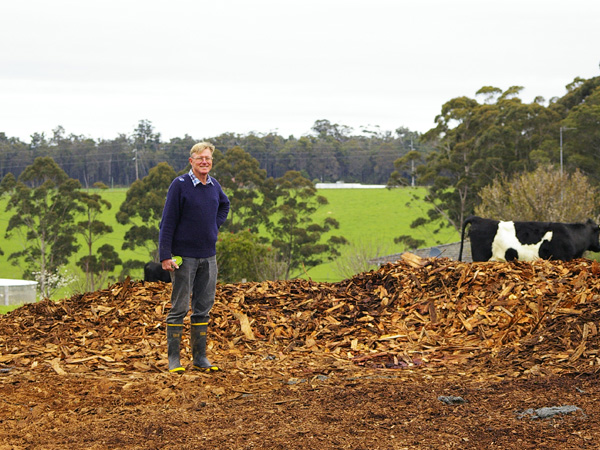Creating ‘volcanic’ soil in WA
By Wendy Wilkins, South West Catchments Council
Innovative thinker and farmer Doug Pow read about the benefits of biochar and decided to trial it on his own cattle and avocado property. The costs of incorporating it into his paddocks were prohibitive, involving machinery he doesn’t like. So, he came up with a unique solution.
In 2011, he began feeding biochar to his cattle so that dung beetles could bury it on his farm in Middlesex, near Manjimup in the south west of Western Australia. This success led Doug to commence a four-year trial in 2014 with biochar in a new avocado orchard to increase drainage and aeration, and facilitate root growth in his soils. Eighteen months after planting, the trees with biochar are twice the size of the control row, and much healthier looking.
“I’ve seen avocados growing on a volcano and I’d like to replicate, as best I can, those andosol soils, because avocadoes have a very high requirement for oxygen in the soil,” Doug said as to why he undertook the trial. “It’s a very tall order in a soil which is of a very high bulk density, like our clays.”

Doug Pow on his Middlesex, WA, farm with wood chips used for mulch.
The trial is comparing three amounts of biochar – 20 percent, 10 percent and 5 percent by soil volume incorporated in the soil to a depth of 600 milimetres. The adjoining control row is planted to avocadoes the standard way.
There are varying soil types within the rows. At the top of the hill is a red chromosol soil, otherwise known as karri loam, on a clay subsoil and as you go further down the hill it graduates into a brown chromosol, and then into a pure laterite with no clay at 600mm.
Each of the different volumes of biochar were placed under groups of four trees, which resulted in 12 trees on each of the soil types down the hill.
Two of each block of four trees is mulched with biochar-enhanced mulch under trees in both the control and the trial rows. You can’t see any effect from that in either row. But that can’t be said for biochar when it’s incorporated into the soil.
“It’s quite astounding the way it has enhanced the evenness of growth and the consistency of tree size, trunk size, root volume, and its ability to absorb nutrients,” Doug said.
“The avocado growers that see the trial are very impressed that it grows such a big tree so quickly, because little weak trees are susceptible to all sorts of things. So getting a tree up quickly is a real head start and if you can cut a year off your wait for the trees to fruit, then that is an economic return,” he said.
“It’s interesting that we have tested 5 percent to 20 percent biochar, which is a 400 percent increase in biochar proportion in the soil, but the trees look exactly the same. So the chances are 20 percent is not too much and 5 percent is not too little.
“The first test will be in fruit volume, fruit quality and fruit size, while the biggest test will be if it affects biennial bearing. It’s ability to help the tree survive attack by Phytophthora cinnamomi (dieback) will also be very interesting.
“Every tree I plant from now on, I would plant in biochar – that’s lesson number one, in flashing lights,” Doug concluded.
To see the full trial update, including how the trial was established, go to http://ow.ly/4iFP30a65cz.
The project is supported by the South West Catchments Council through funding from the Australian Government’s National Landcare Programme.



